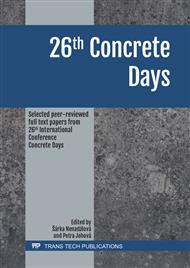p.174
p.180
p.186
p.193
p.201
p.208
p.216
p.222
p.228
Large-Size Jointless Concrete Slab-on-Grade with Combined Prestressing
Abstract:
In the international and national practice of design, a different type of slab on the various types of grade are becoming increasingly common. For such structural elements, shrinkage and temperature influences in combination with low tensile stress, mainly in early age, leads to the risk of cracking in reinforced concrete structures, and as result, a reduction of its durability. The present article describes some of the possible ways of usage of the post-tensioned flat slabs and the rational design procedures to provide their structural reliability. The theoretical background of the punching resistance checking, in the case when the piles support the foundation post-tensioned slabs, presented. For ground floor slabs, an iterative method is given for determining design compression pre-stresses distribution in slab sections, taking into account the restrained effect created by the friction shear stresses in contact between the slab and the base. Besides, the article presents some practical implementations of the post-tensioned slabs as an artificial base in the presence of weak soils and as a large-size ground floor (slab-on-grade) without any joints.
Info:
Periodical:
Pages:
201-207
Citation:
Online since:
August 2020
Authors:
Keywords:
Price:
Сopyright:
© 2020 Trans Tech Publications Ltd. All Rights Reserved
Share:
Citation:


